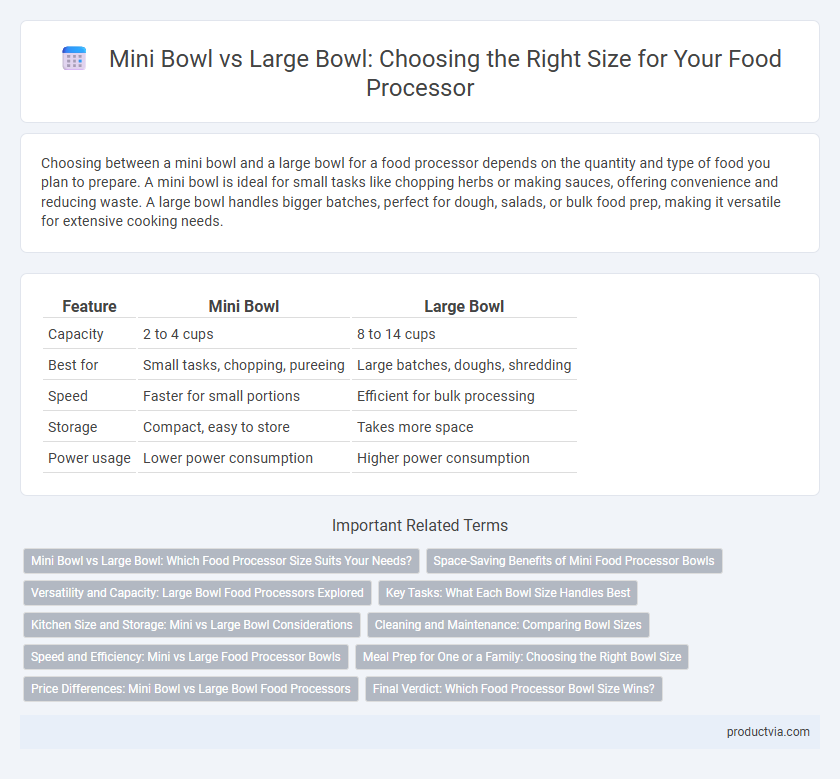Choosing between a mini bowl and a large bowl for a food processor depends on the quantity and type of food you plan to prepare. A mini bowl is ideal for small tasks like chopping herbs or making sauces, offering convenience and reducing waste. A large bowl handles bigger batches, perfect for dough, salads, or bulk food prep, making it versatile for extensive cooking needs.
Table of Comparison
| Feature | Mini Bowl | Large Bowl |
|---|---|---|
| Capacity | 2 to 4 cups | 8 to 14 cups |
| Best for | Small tasks, chopping, pureeing | Large batches, doughs, shredding |
| Speed | Faster for small portions | Efficient for bulk processing |
| Storage | Compact, easy to store | Takes more space |
| Power usage | Lower power consumption | Higher power consumption |
Mini Bowl vs Large Bowl: Which Food Processor Size Suits Your Needs?
Mini bowls in food processors typically range from 3 to 5 cups, making them ideal for chopping small quantities, grinding nuts, or preparing dressings, offering convenience and speed for everyday tasks. Large bowls, usually 9 to 14 cups, handle bulkier ingredients or larger batches, perfect for kneading dough, shredding vegetables, and making big meals for families or gatherings. Choosing between a mini or large bowl depends on your cooking volume, storage space, and the frequency of food preparation, ensuring efficiency and reducing cleanup time.
Space-Saving Benefits of Mini Food Processor Bowls
Mini food processor bowls offer significant space-saving benefits by being compact and easier to store in kitchen cabinets or drawers, making them ideal for small kitchens or limited countertop space. Their smaller size allows for quick and efficient processing of ingredients like herbs, nuts, and small quantities of vegetables without the bulk of large bowls. Opting for a mini bowl reduces countertop clutter while maintaining functionality for everyday food prep tasks.
Versatility and Capacity: Large Bowl Food Processors Explored
Large bowl food processors offer greater versatility by handling larger quantities of ingredients, making them ideal for batch cooking and complex recipes. Their increased capacity allows users to prepare everything from doughs to salads in one go, reducing the need for multiple processing sessions. These processors cater to families and avid cooks who require efficiency and the ability to process bulky or diverse food items quickly.
Key Tasks: What Each Bowl Size Handles Best
Mini bowls excel at precise tasks such as chopping nuts, dicing small vegetables, and making sauces due to their compact size and efficient processing power. Large bowls are ideal for bulk preparations like mixing dough, shredding large quantities of cheese, and slicing multiple vegetables quickly, saving time in meal preparation. Choosing the right bowl size enhances efficiency by matching capacity with the specific food preparation task, optimizing performance and minimizing waste.
Kitchen Size and Storage: Mini vs Large Bowl Considerations
Mini bowls in food processors are ideal for small kitchens and limited storage spaces, offering compactness and ease of handling for quick tasks like chopping herbs or making sauces. Large bowls suit spacious kitchens and frequent batch cooking, providing greater capacity for processing bigger quantities of ingredients at once. Choosing between mini and large bowls depends on available kitchen space and storage infrastructure to ensure both convenience and functionality.
Cleaning and Maintenance: Comparing Bowl Sizes
Mini bowls in food processors offer easier cleaning and maintenance due to their smaller size and fewer parts, reducing dishwasher load and drying time. Large bowls, while more versatile for bigger batches, often require more thorough scrubbing to remove food residues from wider surfaces and crevices. Choosing a mini bowl typically saves time in upkeep, whereas large bowls demand more effort but accommodate bulk processing tasks.
Speed and Efficiency: Mini vs Large Food Processor Bowls
Mini food processor bowls typically offer faster processing speeds for small tasks due to their compact size, enabling more efficient chopping and mixing with minimal effort. Large bowls excel in handling bulk ingredients, reducing the number of batches needed and improving overall efficiency for extensive food preparation. Choosing between mini and large bowls depends on balancing the speed advantages of small capacity with the volume efficiency of larger capacity.
Meal Prep for One or a Family: Choosing the Right Bowl Size
Mini bowls in food processors offer convenience for meal prep for one, efficiently handling small batches like chopping herbs or making single-serve sauces. Large bowls accommodate family-sized portions, ideal for shredding vegetables or mixing dough in bulk, reducing preparation time for group meals. Selecting a bowl size depends on meal prep frequency and portion requirements, balancing storage space with capacity needs.
Price Differences: Mini Bowl vs Large Bowl Food Processors
Mini bowl food processors generally cost less upfront due to their smaller capacity and simpler motor design, making them ideal for quick, small tasks like chopping herbs or grinding nuts. Large bowl food processors command higher prices as they feature more powerful motors and greater capacity, suitable for extensive meal preparation such as dough kneading and slicing larger quantities of vegetables. Price differences between mini and large bowl models often reflect variations in size, motor power, and included accessories, with mini processors offering budget-friendly convenience and large processors delivering versatile performance.
Final Verdict: Which Food Processor Bowl Size Wins?
The choice between a mini bowl and a large bowl for a food processor depends on your typical cooking needs and kitchen space. Mini bowls excel in processing small quantities quickly, ideal for chopping herbs, nuts, or making small batches of sauces, while large bowls offer versatility and efficiency for handling large volumes, perfect for dough preparation, salads, or shredding vegetables. For households frequently preparing diverse meals or larger portions, the large bowl is the winner, but for quick, precise tasks and compact kitchens, the mini bowl provides unmatched convenience.
Mini bowl vs Large bowl for food processor Infographic

 productvia.com
productvia.com